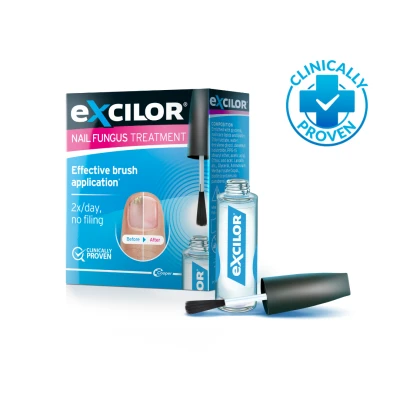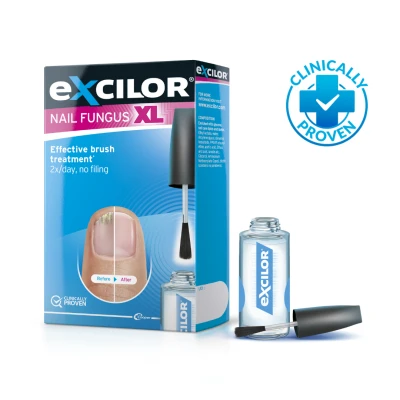Why do you need to take care of your feet?1
Looking after the health of your feet helps:
- Prevent problems when walking and allows you to keep doing sport and physical activities.
- Reduce the risk of falls;
- Prevent foot problems linked to a thickening of skin on your feet (hardened skin, calluses, corns);
- Prevent skin infections (plantar wart, fungus, etc.), trauma and wounds, ingrown toenails and foot deformities (hallux valgus, etc.);
- Avoid complications, if you are diabetic or suffer from vascular problems (peripheral arterial disease in your lower limbs).
Cutting your toenails correctly1
Trimming your toenails is important. In addition to helping you look good, cutting your toenails properly can prevent ingrown toenails.
Cut your toenails by following these steps:
- Place yourself in a well-lit area;
- Slightly soften your toenails in hot water;
- Cut your nails straight; the corners should form a 90o angle. Make sure the top of the nail only protrudes by about 2-3 mm.
- Clean under each nail with an appropriate tool;
- File your nails to make sure the edges are smooth and not sharp;
- Gently cut the cuticles around each nail with a cuticle trimmer.
Good foot hygiene1
Keep your feet clean by washing them once a day. You may need to wash them several times a day if you have very sweaty feet. Daily foot care prevents maceration, which is a risk factor for plantar warts or fungal infections (athlete’s feet, onychomycosis, etc.).
Here are a few practical tips for effective foot care:
- Use water that is not too hot (37°C maximum);
- Use a mild soap (e.g. soap made with vegetable oil) or a soap-free bar;
- Rinse thoroughly;
- If you have any calluses, gently break them down with a pumice stone to remove the excess layer of skin (hyperkeratosis).
- Avoid frequent baths and, if you do take a bath, only stay in it for 10 minutes, to prevent your skin from softening and weakening.
- When you have finished washing, dry your feet with a clean towel making sure you dry the skin between your toes to prevent maceration.
Have a pedicure every three months2, 3, 4, 5, 6
Podiatric care is a medical act performed by a pedicurist/podiatrist to prevent and treat conditions that affect the skin and toenails on your feet. It can be used to treat hyperkeratosis (corns), nail problems and ingrown toenails. It involves several steps: The podiatrist starts by cutting the toenails and treating, if necessary, any ingrown toenails. Toenails are then milled. This consists of pushing down the cuticles, milling down any thickened or misshapen nails and smoothing down their edges, to prevent them from snagging. After milling down the nails, the podiatrist removes any excess skin from the nail grooves. The foot specialist then treats, if necessary, any calluses, corns, warts and fungal infections (of the nail or skin). The next stage involves removing corns from the support areas of the foot (the heel and the forefoot at the metatarsal bones), using a blade. The pedicure treatment ends by applying cream to moisturise the feet.
The frequency of pedicure treatments will depend on the state of your feet. It is recommended once every four months for optimal monitoring and care of your feet.
As well as looking good, a pedicure treatment helps reduce pain, and treat and prevent the consequences of certain conditions.
Exfoliating and moisturising7
Exfoliating and moisturising products are not just for the face and body. Cosmetics specially designed for the skin on your feet are also available.
We recommend using a foot scrub once or twice a week. Scrubs help remove dead skin and increase the absorption of moisturising, repairing and nourishing products. Gently rub your feet with the exfoliant using small circular movements.
We also recommend applying cream for dry skin at least once a week, or more often if you have very dry skin on your feet. Two types of cream are available:
- Moisturising creams for dry feet, applied regularly, will moisturise the skin, relieve any pain and prevent the consequences of certain conditions.
- Anti-hard-skin creams that not only moisturise the skin but also reduce the thickness of the layer of skin on your heels and under the forefoot, thanks to keratolytic active ingredients (urea, acids).
Taking care of your toenails
Some actions can damage your toenails, i.e. sports that involve multiple knocks and blows to the toenails. The repeated use of nail polish and hard nail-polish removers can also damage the keratinisation of the nail, increasing the risk of unevenness, splitting and yellowing.
Some care products (serums, oils, nail polish, etc.) can be used to preserve your nails. Use them regularly to preserve your nails and also the surrounding skin (cuticles).






